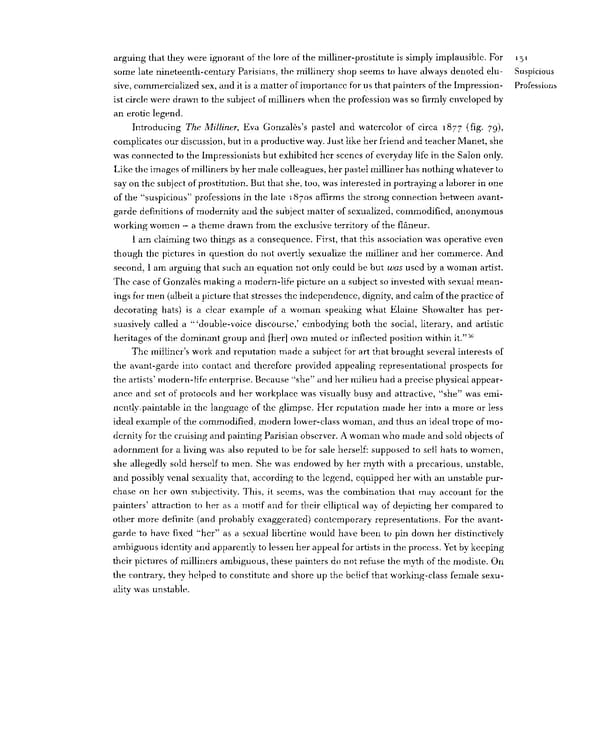arguing that they were ignorant of the lore of the milliner-prostitute is simply implausible. For 131 s some late nineteenth-century Parisians, the millinery shop seems to have always denoted elu- Suspiciou sive, commercialized sex, and it is a matter of importance for us that painters of the Impression- Professions ist circle were drawn to the subject of milliners when the profession was so firmly enveloped by an erotic legend. Introducing The Milliner, Eva Gonzales's pastel and watercolor of circa 1877 (fig. 79), complicates our discussion, but in a productive way. Just like her friend and teacher Manet, she was connected to the Impressionists but exhibited her scenes of everyday life in the Salon only. Like the images of milliners by her male colleagues, her pastel milliner has nothing whatever to say on the subject of prostitution. But that she, too, was interested in portraying a laborer in one of the "suspicious" professions in the late 18708 affirms the strong connection between avant- garde definitions of modernity and the subject matter of sexualized, commodified, anonymous working women — a theme drawn from the exclusive territory of the flaneur. I am claiming two things as a consequence. First, that this association was operative even though the pictures in question do not overtly sexualize the milliner and her commerce. And second, I am arguing that such an equation not only could be but was used by a woman artist. The case of Gonzales making a modern-life picture on a subject so invested with sexual mean- ings for men (albeit a picture that stresses the independence, dignity, and calm of the practice of decorating hats) is a clear example of a woman speaking what Elaine Showalter has per- suasively called a '"double-voice discourse,' embodying both the social, literary, and artistic 36 heritages of the dominant group and [her] own muted or inflected position within it." The milliner's work and reputation made a subject for art that brought several interests of the avant-garde into contact and therefore provided appealing representational prospects for the artists' modern-life enterprise. Because "she" and her milieu had a precise physical appear- ance and set of protocols and her workplace was visually busy and attractive, "she" was emi- nently >paintable in the language of the glimpse. Her reputation made her into a more or less ideal example of the commodified, modern lower-class woman, and thus an ideal trope of mo- dernity for the cruising and painting Parisian observer. A woman who made and sold objects of adornment for a living was also reputed to be for sale herself: supposed to sell hats to women, she allegedly sold herself to men. She was endowed by her myth with a precarious, unstable, and possibly venal sexuality that, according to the legend, equipped her with an unstable pur- chase on her own subjectivity. This, it seems, was the combination that may account for the painters' attraction to her as a motif and for their elliptical way of depicting her compared to other more definite (and probably exaggerated) contemporary representations. For the avant- garde to have fixed "her" as a sexual libertine would have been to pin down her distinctively ambiguous identity and apparently to lessen her appeal for artists in the process. Yet by keeping their pictures of milliners ambiguous, these painters do not refuse the myth of the modiste. On the contrary, they helped to constitute and shore up the belief that working-class female sexu- ality was unstable.
 Prostitution & Impressionists Page 151 Page 153
Prostitution & Impressionists Page 151 Page 153